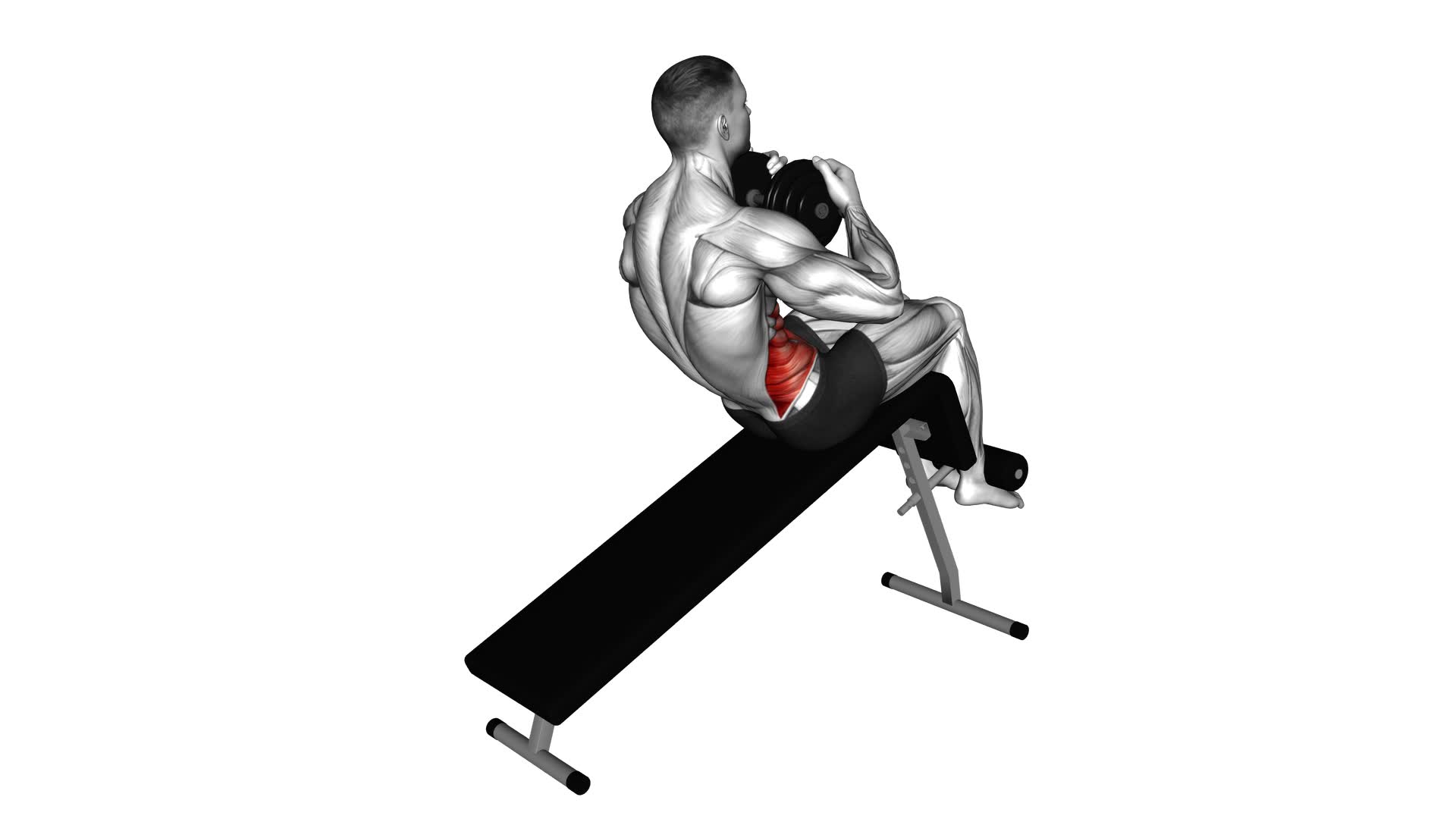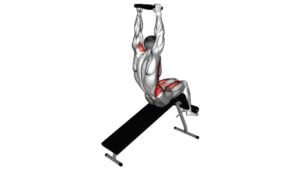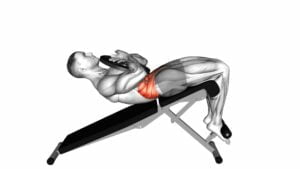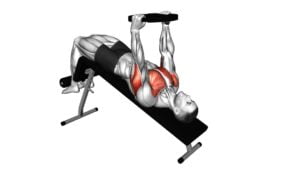Weighted Decline Twist Sit-up (male) – Video Exercise Guide & Tips

Looking to level up your ab workout? Check out the weighted decline twist sit-up! This exercise targets your core muscles, helping you build strength and definition.
Watch This Exercise Video
In this video exercise guide, we'll show you the proper form and technique, as well as advanced variations and progressions.
Don't let common mistakes hold you back – we'll also share tips on how to avoid them.
Get ready to challenge yourself and take your ab game to the next level!
Key Takeaways
- Weighted decline twist sit-ups build core strength and increase abdominal muscle definition.
- The exercise targets the rectus abdominis and obliques, improving stability and posture.
- Proper form and technique are important to prevent injuries and effectively engage core muscles.
- Advanced variations and progressions can be incorporated to enhance core strength and overall fitness level.
Benefits of Weighted Decline Twist Sit-up
You will experience three key benefits from performing the Weighted Decline Twist Sit-up.
First, this exercise is highly effective in building core strength. By incorporating weights and twisting movements, it engages not only your abdominal muscles but also your obliques and lower back muscles. This comprehensive activation of your core muscles helps to improve stability, posture, and overall functional strength.
Second, the Weighted Decline Twist Sit-up aids in increasing abdominal muscle definition. The added resistance from the weights challenges your muscles, promoting hypertrophy and growth. As a result, your abs become more toned and defined, giving you that sought-after six-pack look.
Lastly, this exercise targets both the rectus abdominis and the obliques, providing a balanced development of your abdominal muscles. This balanced approach not only enhances aesthetics but also improves overall core strength and stability, which is crucial for various daily activities and sports performance.
In order to maximize the benefits of the Weighted Decline Twist Sit-up, it's important to perform the exercise with proper form and technique. Let's delve into the next section to learn more about the correct execution of this exercise.
Proper Form and Technique
To execute the Weighted Decline Twist Sit-up with proper form and technique, focus on maintaining a controlled and fluid motion throughout the exercise. Here are some key points to keep in mind to ensure you get the most out of this exercise:
- Engage your core: The Weighted Decline Twist Sit-up is a fantastic exercise for developing core strength. To maximize the benefits, focus on contracting your abdominal muscles throughout the movement. This will help stabilize your body and protect your lower back.
- Control the descent: As you lower yourself back down to the starting position, make sure to maintain control. Avoid simply dropping your torso back down. Instead, slowly and steadily lower yourself to the starting position to engage your core muscles and work them effectively.
- Modify for your fitness level: The Weighted Decline Twist Sit-up can be tailored to suit different fitness levels. If you're a beginner, you may choose to perform the exercise without any weights. As you progress, you can gradually add weights to increase the challenge and further develop your core strength.
Equipment and Weight Selection
When selecting equipment and weights for the Weighted Decline Twist Sit-up, it's important to consider your fitness level and goals. Beginners should start with lighter weights or no weight at all to focus on mastering the proper form and technique. It's recommended to begin with bodyweight exercises such as regular decline twist sit-ups, side plank rotations, and Russian twists to build core strength and stability before incorporating weights.
To prevent injuries during weighted decline twist sit-ups, it's crucial to maintain proper form throughout the exercise. Keep your back flat against the decline bench and engage your core muscles to stabilize your body. Avoid jerking or using momentum to complete the movement, as this can strain your lower back. Start with a weight that challenges you but allows you to maintain control and proper form. Gradually increase the weight as your strength and technique improve.
As you become more comfortable and stronger with the Weighted Decline Twist Sit-up, you can progress to more advanced variations and progressions. These may include using heavier weights, adding resistance bands, or incorporating additional twists or rotations into the exercise. These variations will further challenge your core muscles and help you achieve your fitness goals.
Now that you understand the importance of equipment and weight selection, let's move on to exploring advanced variations and progressions of the Weighted Decline Twist Sit-up.
Advanced Variations and Progressions
To advance your Weighted Decline Twist Sit-up routine, incorporate additional challenges and variations that target your core muscles. Here are three advanced progressions for your core strength training:
- Weighted Decline Twist Sit-up with Resistance Band: Attach a resistance band to a stable anchor behind you and hold the other end across your shoulders. As you perform the sit-up, the band will provide extra resistance, intensifying the exercise and engaging your core muscles even more.
- Russian Twist with Medicine Ball: Sit on the decline bench with your feet secured. Hold a medicine ball with both hands, and as you sit up, twist your torso to one side, bringing the medicine ball towards the floor. Return to the starting position, then twist to the other side. This variation adds rotational movement, challenging your core muscles from different angles.
- Weighted Decline Twist Sit-up with Dumbbells: Hold a pair of dumbbells at your chest while performing the sit-up. The added weight will increase the difficulty and engage your core muscles even further.
By incorporating these advanced variations and progressions into your routine, you can continue to challenge your core strength and enhance your overall fitness level.
Now, let's move on to the next section and discuss common mistakes and how to avoid them.
Common Mistakes and How to Avoid Them
Avoidance of common mistakes is crucial for maximizing the effectiveness of your Weighted Decline Twist Sit-up routine.
To ensure you make the most out of this exercise, it's important to be aware of the common mistakes and learn how to avoid them.
One common mistake is using too much momentum. When performing the sit-up, it's important to engage your core muscles and avoid using momentum to lift yourself up. This can be achieved by controlling the movement and focusing on the contraction of your abdominal muscles.
Another mistake to avoid is rounding your back during the exercise. This can put unnecessary strain on your spine and decrease the effectiveness of the sit-up. Instead, maintain a neutral spine throughout the movement by keeping your back straight and your shoulders pulled back.
Lastly, it's important to avoid pulling on your neck or using your hands to push yourself up. This can strain your neck and take away from the targeted abdominal workout. Instead, keep your hands lightly touching your temples and engage your core to perform the sit-up.
Frequently Asked Questions
How Many Calories Can Be Burned by Doing Weighted Decline Twist Sit-Ups?
Weighted decline twist sit-ups are a great exercise for improving core strength and stability. By incorporating weights, you can increase the intensity and challenge your muscles even more.
However, when it comes to calorie burn, it's important to remember that the number of calories burned will vary depending on factors like your weight, intensity, and duration of the exercise.
To maximize calorie burn, focus on maintaining proper form and technique throughout the exercise.
Can Weighted Decline Twist Sit-Ups Help in Reducing Belly Fat?
Weighted decline twist sit-ups can be an effective exercise for reducing belly fat. By incorporating variations of this exercise into your routine, such as using weights or adding twists, you can target your abdominal muscles and increase the intensity of the workout.
The benefits of weighted decline twist sit-ups include strengthening your core, improving posture, and burning calories. Consistency and proper form are key to achieving optimal results.
How Often Should Weighted Decline Twist Sit-Ups Be Performed to See Results?
To see results from weighted decline twist sit-ups, it's important to perform them with the ideal frequency. Consistency is key! Aim to do these exercises at least 2-3 times a week. This will allow your muscles to recover and grow stronger.
Additionally, try incorporating different variations of the exercise to keep challenging your body and prevent boredom. Remember to always use proper form and start with a weight that's comfortable for you.
Are There Any Alternative Exercises That Target the Same Muscle Groups as Weighted Decline Twist Sit-Ups?
If you're looking for alternative exercises that target the same muscle groups as weighted decline twist sit-ups, there are a few options you can try.
Plank twists, Russian twists, and bicycle crunches are all effective alternatives that engage your core and oblique muscles.
However, it's important to note that weighted decline twist sit-ups offer unique benefits, such as increased resistance and a greater range of motion.
Can Weighted Decline Twist Sit-Ups Help in Improving Sports Performance?
Weighted decline twist sit-ups can be beneficial for improving agility and increasing core strength. By engaging your core muscles and incorporating rotational movements, these sit-ups can help enhance your athletic performance.
They target the muscles responsible for stability and rotational power, which are essential for many sports. Incorporating weighted decline twist sit-ups into your exercise routine can help you develop a strong and stable core, leading to improved sports performance.
Conclusion
In conclusion, weighted decline twist sit-ups are an effective exercise for targeting the core muscles and improving overall strength and stability.
By following proper form and technique, using the appropriate equipment and weight selection, and avoiding common mistakes, you can maximize the benefits of this exercise.
Remember to consult with a fitness professional if you're unsure about your ability to perform this exercise safely.
Keep up the good work and enjoy the results of your hard work!

Author
Years ago, the spark of my life’s passion ignited in my mind the moment I stepped into the local gym for the first time. The inaugural bead of perspiration, the initial endeavor, the very first surge of endorphins, and a sense of pride that washed over me post-workout marked the beginning of my deep-seated interest in strength sports, fitness, and sports nutrition. This very curiosity blossomed rapidly into a profound fascination, propelling me to earn a Master’s degree in Physical Education from the Academy of Physical Education in Krakow, followed by a Sports Manager diploma from the Jagiellonian University. My journey of growth led me to gain more specialized qualifications, such as being a certified personal trainer with a focus on sports dietetics, a lifeguard, and an instructor for wellness and corrective gymnastics. Theoretical knowledge paired seamlessly with practical experience, reinforcing my belief that the transformation of individuals under my guidance was also a reflection of my personal growth. This belief holds true even today. Each day, I strive to push the boundaries and explore new realms. These realms gently elevate me to greater heights. The unique combination of passion for my field and the continuous quest for growth fuels my drive to break new ground.



